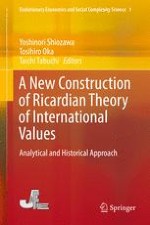2017 | OriginalPaper | Chapter
Comparative Advantage in the Light of the Old Value Theories
Author : Taichi Tabuchi
Published in: A New Construction of Ricardian Theory of International Values
Publisher: Springer Singapore
Activate our intelligent search to find suitable subject content or patents.
Select sections of text to find matching patents with Artificial Intelligence. powered by
Select sections of text to find additional relevant content using AI-assisted search. powered by
